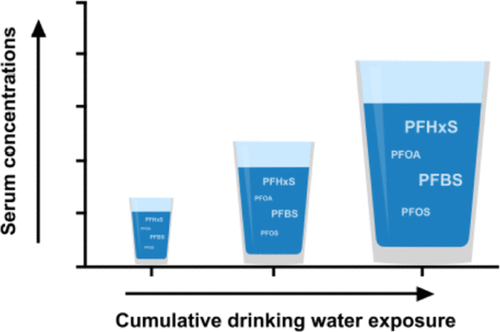当前位置:
X-MOL 学术
›
Environ. Sci. Technol.
›
论文详情
Our official English website, www.x-mol.net, welcomes your
feedback! (Note: you will need to create a separate account there.)
Perfluoroalkyl Acids in Children’s Serum and Contribution from Perfluoroalkyl Acid-Contaminated Drinking Water
Environmental Science & Technology ( IF 10.8 ) Pub Date : 2019-09-16 , DOI: 10.1021/acs.est.9b01746
Irina Gyllenhammar 1 , Jonathan P. Benskin 2 , Oskar Sandblom 2 , Urs Berger 3 , Lutz Ahrens 4 , Sanna Lignell 1 , Karin Wiberg 4 , Anders Glynn 5
Environmental Science & Technology ( IF 10.8 ) Pub Date : 2019-09-16 , DOI: 10.1021/acs.est.9b01746
Irina Gyllenhammar 1 , Jonathan P. Benskin 2 , Oskar Sandblom 2 , Urs Berger 3 , Lutz Ahrens 4 , Sanna Lignell 1 , Karin Wiberg 4 , Anders Glynn 5
Affiliation

|
We investigated associations between serum perfluoroalkyl acid (PFAA) concentrations in children aged 4, 8, and 12 years (sampled in 2008–2015; n = 57, 55, and 119, respectively) and exposure via placental transfer, breastfeeding, and ingestion of PFAA-contaminated drinking water. Sampling took place in Uppsala County, Sweden, where the drinking water has been historically contaminated with perfluorobutanesulfonate (PFBS), perfluorohexanesulfonate (PFHxS), perfluorooctanesulfonate (PFOS), perfluoroheptanoate (PFHpA), and perfluorooctanoate (PFOA). PFOS showed the highest median concentrations in serum (3.8–5.3 ng g–1 serum), followed by PFHxS (1.6–5.0 ng g–1 serum), PFOA (2.0–2.5 ng g–1 serum), and perfluorononanoate (PFNA) (0.59–0.69 ng g–1 serum) in children. Including all children, serum PFOA, PFHxS, and PFOS concentrations in children increased 10, 10, and 1.3% (adjusted mean), respectively, per unit (ng g–1 serum) of increase in the maternal serum level (at delivery), the associations being strongest for 4 year-old children. PFHxS and PFOS significantly increased 3.9 and 3.8%, respectively, per month of nursing, with the highest increase for 4 year-olds. PFOA, PFBS, PFHxS, and PFOS increased 1.2, 207, 7.4, and 0.93%, respectively, per month of cumulative drinking water exposure. Early life exposure to PFOA, PFHxS, and PFOS is an important determinant of serum concentrations in children, with the strongest influence on younger ages. Drinking water with low to moderate PFBS, PFHxS, PFOS, and PFOA contamination is an important source of exposure for children with background exposure from other sources.
中文翻译:

儿童血清中的全氟烷基酸和全氟烷基酸污染的饮用水中的贡献
我们调查了4岁,8岁和12岁儿童的全氟烷基酸(PFAA)浓度(分别于2008-2015年抽样;n = 57、55和119)与通过胎盘转移,母乳喂养和摄食婴儿的暴露之间的关联。受PFAA污染的饮用水。采样在瑞典的乌普萨拉县进行,该饮用水在历史上曾被全氟丁烷磺酸盐(PFBS),全氟己烷磺酸盐(PFHxS),全氟辛烷磺酸盐(PFOS),全氟庚酸酯(PFHpA)和全氟辛酸(PFOA)污染。PFOS的血清中值浓度最高(3.8–5.3 ng g –1血清),其次是PFHxS(1.6–5.0 ng g –1血清),PFOA(2.0–2.5 ng g – 1血清)血清)和全氟壬酸(PFNA)(0.59–0.69 ng g –1血清)。包括所有儿童在内,儿童的血清PFOA,PFHxS和PFOS浓度每单位分别增加10%,10%和1.3%(调整后平均值)(ng g –1)产妇血清水平(分娩时)增加,这种关联对4岁的孩子最强。PFHxS和PFOS分别每月显着增加3.9和3.8%,其中4岁儿童的增幅最高。每月的累积饮用水暴露量分别为PFOA,PFBS,PFHxS和PFOS分别增加1.2%,207%,7.4%和0.93%。尽早接触PFOA,PFHxS和PFOS是儿童血清浓度的重要决定因素,对幼儿的影响最大。PFBS,PFHxS,PFOS和PFOA污染程度低至中度的饮用水是其他背景暴露儿童的重要暴露来源。
更新日期:2019-09-16
中文翻译:

儿童血清中的全氟烷基酸和全氟烷基酸污染的饮用水中的贡献
我们调查了4岁,8岁和12岁儿童的全氟烷基酸(PFAA)浓度(分别于2008-2015年抽样;n = 57、55和119)与通过胎盘转移,母乳喂养和摄食婴儿的暴露之间的关联。受PFAA污染的饮用水。采样在瑞典的乌普萨拉县进行,该饮用水在历史上曾被全氟丁烷磺酸盐(PFBS),全氟己烷磺酸盐(PFHxS),全氟辛烷磺酸盐(PFOS),全氟庚酸酯(PFHpA)和全氟辛酸(PFOA)污染。PFOS的血清中值浓度最高(3.8–5.3 ng g –1血清),其次是PFHxS(1.6–5.0 ng g –1血清),PFOA(2.0–2.5 ng g – 1血清)血清)和全氟壬酸(PFNA)(0.59–0.69 ng g –1血清)。包括所有儿童在内,儿童的血清PFOA,PFHxS和PFOS浓度每单位分别增加10%,10%和1.3%(调整后平均值)(ng g –1)产妇血清水平(分娩时)增加,这种关联对4岁的孩子最强。PFHxS和PFOS分别每月显着增加3.9和3.8%,其中4岁儿童的增幅最高。每月的累积饮用水暴露量分别为PFOA,PFBS,PFHxS和PFOS分别增加1.2%,207%,7.4%和0.93%。尽早接触PFOA,PFHxS和PFOS是儿童血清浓度的重要决定因素,对幼儿的影响最大。PFBS,PFHxS,PFOS和PFOA污染程度低至中度的饮用水是其他背景暴露儿童的重要暴露来源。

































 京公网安备 11010802027423号
京公网安备 11010802027423号